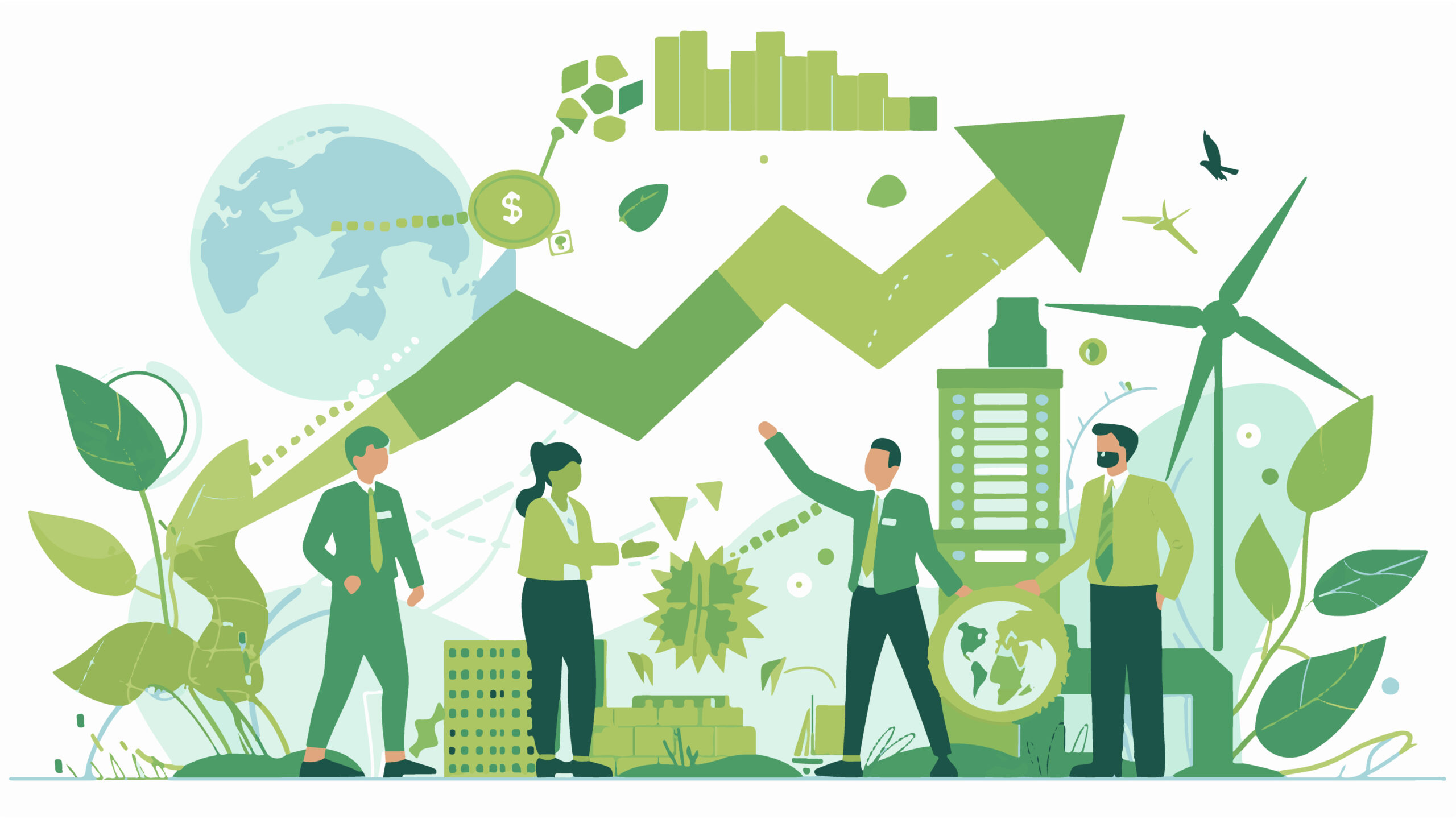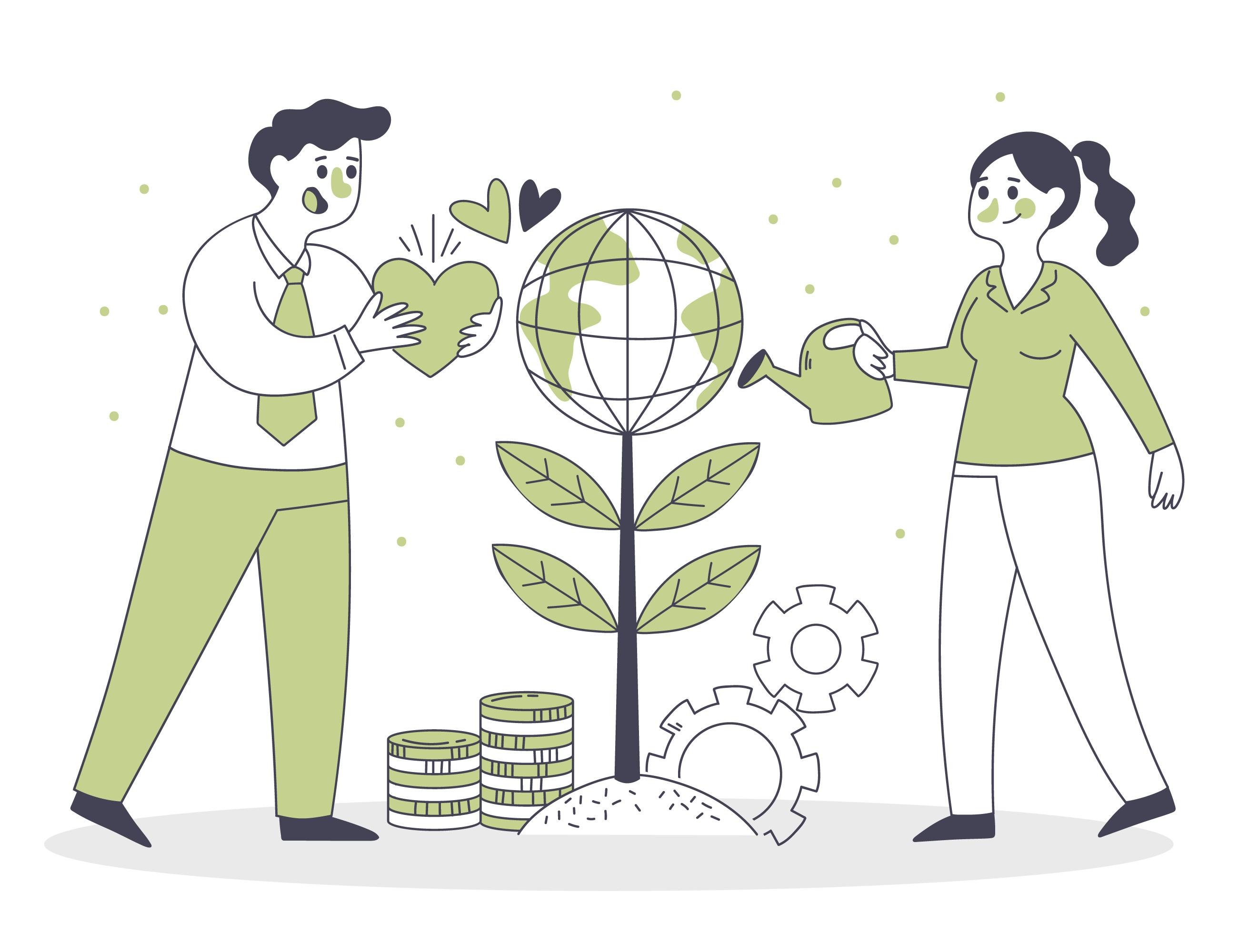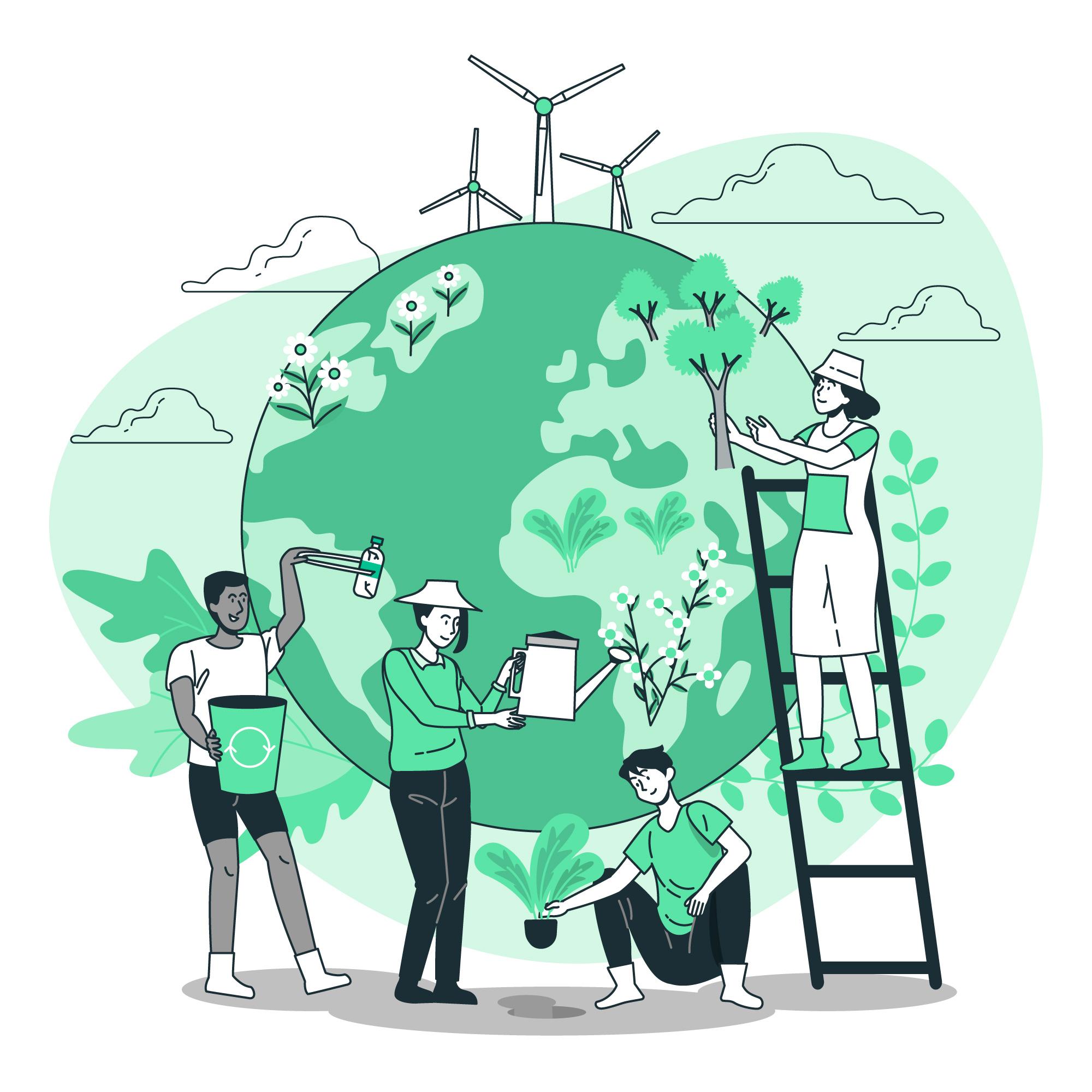The idea of a green economy isn’t just about planting more trees or banning plastic—it’s about rethinking how economies grow while staying within the Earth’s ecological limits.
Instead of treating environmental impact as an afterthought, the green economy places it at the core of decision-making. That includes investing in renewable energy, improving efficiency, designing for circularity, and ensuring that growth benefits are equitably shared.
This shift matters because our current extract-use-dispose model isn’t just unsustainable—it’s increasingly unstable. Climate disruptions, resource scarcity, and supply chain fragility all point to the same truth: we need an economy that works with nature, not against it.
The green economy offers that path—one where environmental integrity and economic resilience go hand in hand.
What Is a Green Economy?

A green economy is one that supports growth while keeping nature and future generations in mind. The UNEP defines it as “low carbon, resource-efficient, and socially inclusive.” That’s not just idealism—it’s a strategy to keep economies competitive and climate risks in check.
In a green economy:
- Natural resources are treated as assets, not as limitless inputs.
- Growth comes from innovation in clean energy, sustainable farming, and low-impact manufacturing.
- Policies support long-term resilience over short-term profit.
- Jobs and opportunity are created in ways that reduce environmental harm—not cause it.
In contrast, traditional economic systems often ignore the environmental cost of doing business. A green economy fixes that blind spot by making sustainability part of how we measure success.
Green Economy in Practice: What It Actually Looks Like

The green economy isn’t a future vision—it’s already happening. Cities are upgrading to energy-efficient buildings. Farmers are switching to regenerative methods. Businesses are ditching plastic for compostable or refillable packaging. And governments are setting targets for net-zero emissions and biodiversity protection.
What ties these actions together is a mindset shift: instead of choosing between growth and sustainability, we’re starting to expect both. That’s the core of the green economy.
In practice, it means:
- Investing in sectors that cut emissions and create jobs (like clean energy and public transport)
- Designing products and services to last longer, waste less, and use fewer virgin materials
- Tracking environmental impact alongside financial returns
For example, Unilever has pledged to make 100% of its plastic packaging reusable, recyclable, or compostable by 2025 and has already reached 52%. It also aims to cut virgin plastic use in half, investing in refillables, recycled content, and alternative materials (Source).
It’s not about slowing down progress—it’s about making sure we’re building something that lasts.
Green Economy vs Circular Economy: What’s the Difference?
While often used interchangeably, the green economy and the circular economy are distinct frameworks, each addressing sustainability through different levers.
The green economy is a macroeconomic model. It integrates environmental health into economic strategy, aiming for systemic change across energy, infrastructure, agriculture, and finance. The goal? Low-carbon, socially inclusive growth within planetary boundaries. It focuses on broad outcomes—like reducing carbon intensity, preserving biodiversity, and improving resource efficiency—across entire economies.
The circular economy, on the other hand, is a systems-level production model. It zooms in on material and resource flows—designing waste out of the system by reusing, repairing, remanufacturing, and recycling. It aims to decouple growth from raw material extraction by keeping products and materials in circulation for as long as possible. The European Commission defines it as a core strategy for reducing dependency on virgin inputs and managing supply risk.
In practice, a circular economy operates within a green economy. One is a mechanism; the other is a guiding philosophy.
Key Differences at a Glance
| Dimension | Green Economy | Circular Economy |
|---|---|---|
| Primary Focus | Low-carbon, inclusive, and ecologically safe growth | Closed-loop resource cycles to reduce waste and optimize inputs |
| Scope | Macroeconomic; spans energy, transport, land use, and policy frameworks | Micro to meso-level; targets product design, manufacturing, and end-of-life systems |
| Core Principles | Renewable energy, ecosystem preservation, and social equity | Design for reuse, minimize waste, regenerate natural systems |
| Examples | National green stimulus programs, ESG-linked policy incentives | Packaging reuse models, electronics take-back schemes, industrial symbiosis |
| Policy Drivers | UNEP Green Economy Initiative, Net Zero targets, SDGs | EU Circular Economy Action Plan, Extended Producer Responsibility (EPR) |
Together, these models are not in competition—they’re complementary. Circularity offers the material logic that enables a green economy to function within ecological limits. Meanwhile, green economic policy creates the incentives and regulatory frameworks that scale circular design across sectors.
What are the Importance of Green Economy Benefits in India?

India is at a turning point—where environmental urgency meets economic ambition.
As cities expand, industries grow, and climate risks intensify, the country has a unique chance to lead the global move toward sustainable, green growth. By investing in clean technologies, green jobs, and climate-resilient infrastructure, India can drive development that’s both future-ready and environmentally sound.
Here are two main ways this is happening.
1. Environmental Gains and Ecosystem Conservation
India’s move toward a green economy is already yielding significant environmental dividends:
- Emission Reductions: Investments in renewable energy—especially solar and wind—are directly contributing to reduced greenhouse gas emissions, aligning with India’s NDC targets under the Paris Agreement.
- Air and Water Quality: Cleaner energy adoption (e.g., electric mobility, improved cookstoves, solar irrigation) is mitigating particulate matter and water contamination—key drivers of public health issues.
- Natural Capital Accounting: India is piloting System of Environmental Economic Accounting (SEEA) frameworks, incorporating ecosystem services such as water purification, flood protection, and biodiversity into economic decision-making.
- Biodiversity and Forestry: Initiatives like Green India Mission, afforestation drives, and eco-restoration in degraded lands are enhancing forest carbon sinks while supporting community-based conservation.
This ecological transition also supports long-term climate adaptation—especially in vulnerable zones such as the Indo-Gangetic plains and semi-arid regions.
2. Economic Diversification and Job Creation
The green economy is a growth strategy. India’s focus on low-carbon sectors is unlocking significant economic potential:
- Job Multipliers in Clean Energy: According to CEEW and NRDC, India’s solar and wind sectors generated over 100,000 direct jobs between 2017 and 2022, with projections suggesting over 1 million green jobs by 2030 in operations, maintenance, and installation.
- Sustainable Agriculture: Policies promoting natural farming, precision irrigation, and bio-inputs are helping reduce input dependency, improve soil health, and increase farmer resilience—especially under PM-PRANAM and Paramparagat Krishi Vikas Yojana.
- Resource Efficiency and Circular Economy: India’s Resource Efficiency Policy and initiatives like Extended Producer Responsibility (EPR) in plastics and electronics are reducing raw material demand and generating new business models in reuse, remanufacturing, and repair.
- Skilling for Transition: Programs under Skill India and Green Skill Development Programme (GSDP) are upskilling youth and rural communities to meet the growing demand for technical roles in sectors like waste management, clean energy, and biodiversity monitoring.
These pathways reduce exposure to fossil fuel volatility and global compliance risks, while also positioning India as a hub for climate tech innovation and sustainable manufacturing.
What Are the Five Principles of a Green Economy?
The green economy runs on five key principles that help guide smart, fair, and sustainable growth. These principles are about balancing people, planet, and profit, without pushing the planet beyond its limits.
1. Wellbeing First
A green economy puts people and nature first. That means investing in things that actually improve lives—like clean air, education, healthcare, and jobs that support families and communities. Growth only matters if it supports real wellbeing.
2. Fairness for All
The green economy must work for everyone—not just a few. This principle focuses on equity: fair access to resources, jobs, and opportunities. It pushes for policies that include underrepresented communities and protect future generations.
3. Respect for Planetary Limits
We only have one planet—and a green economy respects that. This principle is about staying within the Earth’s safe boundaries: protecting biodiversity, using water wisely, and cutting emissions before damage becomes irreversible.
4. Do More with Less—Then Ask If We Need It
Efficiency matters, but so does sufficiency. This principle encourages us to use fewer resources to get better results—and also to question overconsumption. Do we need to make or ship so much in the first place?
5. Accountable and Transparent Decision-Making
A green economy runs on trust. That means clear rules, honest data, and decisions based on science and community input. Whether it’s government or business, transparency and accountability are non-negotiable.
What Are the Business Opportunities in the Green Economy Transition?
The shift to a green economy isn’t just about compliance—it’s a growth strategy. For businesses, it unlocks new markets, cost savings, and long-term resilience.
1. Low-Carbon Technologies and Energy Innovation
Companies investing in solar, wind, EV infrastructure, and energy storage are tapping into billion-dollar markets. From utility-scale renewable projects to SaaS tools optimizing energy use, there’s a clear ROI in cutting carbon.
- Opportunity: Offer decarbonization-as-a-service to commercial clients
- Example: Startups like Greenly enable businesses to track and reduce emissions with ease
2. Sustainable Product Design and Packaging
Consumer demand is shifting—fast. Businesses offering biodegradable packaging, carbon-neutral products, or durable, refillable formats are not only reducing waste but increasing customer retention.
Starch-based compostable materials—such as PLA+PBAT blends—are becoming go-to solutions for brands seeking packaging that aligns with both regulatory and performance standards. These plant-based polymers offer drop-in replacements for conventional plastics while ensuring industrial compostability under standards like CPCB, EN 13432, and ASTM D6400.
Bonus: Certifications (like CPCB, CIPET) and eco-labels boost credibility and increase platform acceptance in both domestic and export markets.
3. New Revenue Streams: Circular Business Models
The circular economy flips waste into value. By designing for reuse, repair, and recycling, companies lower production costs and improve supply chain resilience.
| Aspect | Circular Opportunity |
|---|---|
| Resource Efficiency | Use recycled content (e.g., aluminum, fiber pulp) |
| Extended Lifespan | Modular design, repairable components |
| Waste Reduction | Closed-loop take-back systems, reverse logistics |
- Example: Lithium battery recycling startups are securing rare minerals while reducing e-waste.
4. Green Finance, Carbon Credits, and Compliance Wins
Businesses going green can access new funding through green bonds, ESG investment pools, and carbon credit markets. Early movers often gain:
- First-mover advantage in sustainable tenders
- Eligibility for export under stricter global regulations
- Higher ESG ratings that attract institutional investors
How Does Sustainability Help Reduce Costs?
Businesses embracing sustainable practices often unlock major cost savings through operational efficiencies and smarter resource management. Here’s how.
- Lower Energy Bills: Transitioning to renewable energy sources like solar or wind significantly reduces long-term utility expenses. Energy-efficient appliances and building upgrades cut consumption further.
- Reduced Material Costs: Sustainable design often leads to leaner material use, while sourcing recycled or renewable inputs helps avoid volatile raw material pricing.
- Avoided Penalties & Compliance Costs: Proactive environmental practices reduce exposure to fines, taxes (like carbon pricing), and regulatory burdens in jurisdictions adopting stricter ESG mandates.
- Waste Minimization: Circular practices like reusing components, recycling packaging, and optimizing production cuts disposal fees and raw input costs—while keeping supply chains resilient.
In short, sustainability translates to leaner, smarter, and more future-proof operations.
What Are Some Real-World Examples of a Green Economy?
Green economy principles are already reshaping industries, infrastructure, and consumer behavior across India. Here’s how theory translates into action:
- Urban Mobility: Electric scooters and e-bikes in cities like Bengaluru and Delhi are reducing fossil fuel reliance, cutting emissions, and enabling low-cost last-mile delivery.
- Battery Recycling: Companies like Attero and Lohum are pioneering lithium-ion battery recovery, minimizing e-waste and reclaiming rare earth materials for reuse.
- Sustainable Farming: Regenerative agriculture and organic farming practices are improving soil health, conserving water, and strengthening biodiversity in rural economies.
- Renewable Energy Projects: Solar installations like Bhadla Solar Park and large-scale wind corridors are transforming India’s energy mix and fueling green industrial zones.
- Eco-Conscious Manufacturing: D2C brands are investing in biodegradable packaging and low-emission logistics to meet carbon-neutral targets and improve brand equity.
- Compostable Packaging Solutions: Sustainable brands like Greenworksbio are enabling this shift by offering CPCB-certified compostable materials—from courier bags to foodservice packaging—that integrate into business workflows. Their solutions help brands reduce landfill waste, meet compliance requirements, and support a truly circular packaging system.
These examples prove that sustainability and profitability are no longer at odds—they’re part of the same future-ready strategy.
Conclusion
The green economy is a practical framework for long-term, inclusive growth. It aligns climate action with economic opportunity, creating systems that generate jobs, encourage innovation, and reduce environmental risks at scale.
For countries like India, this transition opens doors to cleaner industries, resilient supply chains, and global leadership in renewable energy and sustainable manufacturing. For businesses, it’s a chance to future-proof operations, tap into emerging markets, and align with evolving regulations and consumer expectations.
As circular economy models and green finance evolve, the question is no longer if your organization should act—but how soon. Whether you’re a policymaker, entrepreneur, or consumer, your decisions today shape the low-carbon economy of tomorrow.
Now is the time to invest, innovate, and participate in building a greener, more resilient future.
Frequently Asked Questions
1. What is the green economy and how is it defined?
The green economy is defined as an economic model that prioritizes low carbon emissions, energy efficiency, and social inclusivity. According to the United Nations Environment Programme, a green economy is one that results in improved human well-being and social equity, while significantly reducing environmental risks and resource scarcity. It supports both economic growth and ecological balance.
2. What is the importance of the green economy in today’s world?
The importance of the green economy lies in its ability to address urgent global issues like climate change, natural resource depletion, and social development. By promoting green technologies, sustainable consumption, and energy efficiency, it enables long-term economic development that is both inclusive and environmentally responsible.
3. How does the green economy differ from traditional economic activities?
Unlike traditional models that focus on profit and resource extraction, the green economy concept takes a holistic approach by integrating the value of natural assets into economic planning. It supports economic activities that are mutually reinforcing—meaning they benefit the environment, society, and the economy at the same time.
4. What role does policy reform play in building a green economy?
Policy reforms are critical for enabling the transition to a green economy. Governments need to update regulations, remove harmful subsidies, and implement green fiscal policies that encourage green investing, renewable energy use, and sustainable business models. Global organizations like the International Chamber of Commerce also advocate for private-sector involvement in green transitions.
5. How does a green economy promote sustainable consumption and address resource scarcity?
A core pillar of the green economy is reducing the consumption of natural resources through circular economy strategies and sustainable consumption patterns. This helps prevent resource scarcity while creating more efficient systems for production and waste management—making the economy more resilient.
6. Can the green economy drive inclusive economic growth and development?
Yes. An inclusive green economy promotes equitable access to jobs, education, and clean technologies. It ensures that economic development benefits all segments of society, especially vulnerable communities, by focusing on social inclusion, innovation, and long-term resilience.

